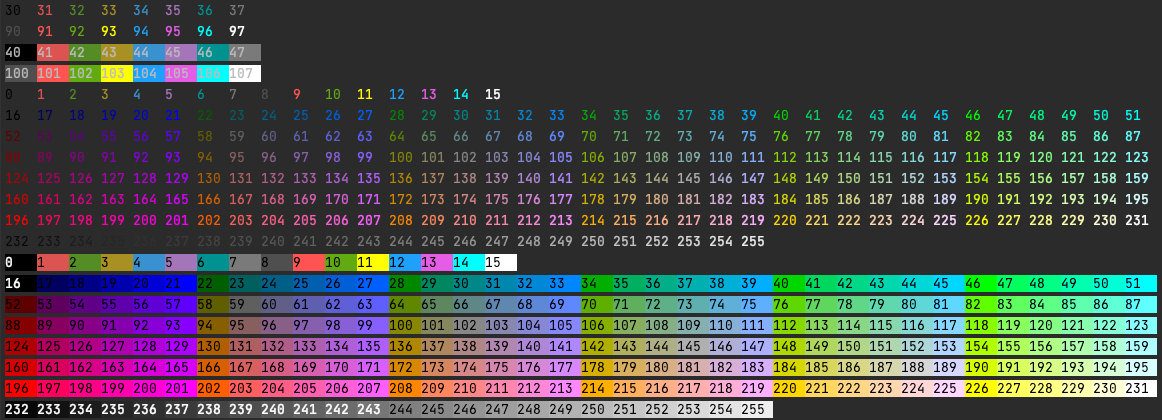A Custom Logger Class for creating colored, adding level, other misc features
Project description
Custom Loggers
A module that extends the standard python logging module
In the standard python logging module there are things that are difficult to accomplish without quite a bit of overhead. These classes are meant to simplify that overhead and to be extended for specific use.
Classes
CustomLogger
from custom_loggers import CustomLogger
Extends the logging.Logger class This is the primary class you will use/inherit
examples
general use:
from custom_loggers import CustomLogger, ColoredFormatter, Foreground255
#setting class level settings
CustomLogger.inclusive = True
CustomLogger.global_log_level = 0
CustomLogger.use_global_log_level_default=True
#assigning a color for a new level which is defined below
ColoredFormatter.assign_level_color("NEWLEVEL", Foreground255(226))
logger = CustomLogger("testLogger")
logger2 = CustomLogger("test2logger")
logger3 = CustomLogger("channel_tester", channel="NewChannel")
logger4 = CustomLogger("channel_tester2", channel="NewChannel")
logger3.info("channel test on")
logger4.info("channel test on")
CustomLogger.channel_disabled("NewChannel", True)
logger3.info("channel test off")
logger4.info("channel test off")
logger2.add_level("NEWLEVEL", 1, True)
logger2.log("NEWLEVEL", "original message")
logger.newlevel("my new message")
logger.log("trace", "just checking")
logger.error("Hello")
logger.info("Hello")
logger.debug("Hello")
logger.warning("Hello")
logger.critical("Hello")
try:
raise ValueError("This is a complex error")
except Exception as e:
logger.exception("An exception occurred")
logger.disabled = True
logger.info("This should not print because is disabled")
logger.disabled = False
CustomLogger.logging_disabled = True
logger.info("Should be disabled")
logger2.info("Should be disabled")
logger3.info("Should be disabled")
logger4.info("Should be disabled")
Extending
from custom_loggers import CustomLogger,ColoredFormatter,Foreground255
class NewLogger(CustomLogger):
use_global_log_level_default = True
inclusive = False
default_colored_format = '%(levelname)-8s: %(message)s'
has_run_once=False
CustomLogger.add_level("NEWLEVEL", 1)
ColoredFormatter.assign_level_color("NEWLEVEL", Foreground255(77))
def newlevel(self,msg):
self.log("NEWLEVEL", msg)
logger=NewLogger("TestLogger")
logger.newlevel("this shows your new level")
class attributes
These values affect every instance of CustomLogger
logging_disabled: bool enables or disables ALL Logging from CustomLogger
default_logging_level: int the logging level assigned to each logger by default
use_global_log_level_default: the default value of use_global_log which is used when comparing a logging event with the
log leve this determines whether we compare with the instance or with the global log_level
global_log_level: int the current log level for all instances. (only effective when use_global_log_level is True)
inclusive: bool when calculating whether to log or not if inclusive is True we'll accept the set log level and below
if false only loglevel matching the exact level will log
default_colored_formatter:Formatter when creating an instance with add_formatter is True this is the class used to
create the formatter
default_colored_format:str the format string that the formatter will use
default_asctime_format:str the asctime format the formatter will use
ColoredFormatter
from custom_loggers import ColoredFormatter
For all things colored
There are 3 Things to note here:
1: Compatibility
Color text doesn't work on all terminals primarily you will find issues in Windows CMD and Powershell. We've set it up to be as compatible as possible however if you need to turn it off you can set WINDOWS_OVERRIDE to True
from custom_loggers import ColoredFormatter
ColoredFormatter.WINDOWS_OVERRIDE = True
2: Color Assignment
ColoredFormatter adds three additional formatting options for your logging format.
All three are associated with getting the script that calls one of a CustomLogger.log methods. It grabs the script
location and assigns this to these formatting names. These are similar to 'filepath', 'filename', 'lineno' but could be
different. These will be more accurate for CustomLoggers.
scriptpath : the full path to the script that called log
scriptname : the file name of the script
scriptline : the line number of the script
As a side note if you use a plugin for your IDE you may be able to get the filename and line number to have be a hyperlink in the IDE's terminal. For example in PyCharm if you use the below format {scriptname}, line {scriptline} and install the Awesome Console plugin. each of those references will take you directly to the script.
from custom_loggers import CustomLogger
CustomLogger.default_colored_format = '%(asctime)s [%(scriptname)s, line %(scriptline)-3s] %(levelname)-8s %(name)s: %(message)s'
# Will output like this
# 21-04-29 08:39 [main.py, line 15 ] INFO channel_tester: channel test on
# 21-04-29 08:39 [main.py, line 16 ] INFO channel_tester2: channel test on
# 21-04-29 08:39 [main.py, line 23 ] TRACE testLogger: just checking
# 21-04-29 08:39 [main.py, line 24 ] ERROR testLogger: Hello
# 21-04-29 08:39 [main.py, line 25 ] INFO testLogger: Hello
# 21-04-29 08:39 [main.py, line 26 ] DEBUG testLogger: Hello
# 21-04-29 08:39 [main.py, line 27 ] WARNING testLogger: Hello
# 21-04-29 08:39 [main.py, line 28 ] WARNING testLogger: Hello
3:
Assigning Colors to level is done like below:
from custom_loggers import ColoredFormatter
from custom_loggers import Colors
ColoredFormatter.assign_level_color("LEVELNAME",Colors.ForeGroundColors.GREEN)
Colored formatter has an assign_level_color method used to assign foreground and background colors. This is done via the Colors module discussed below. the color can be a string (usually a color escape color which is put in front of the log line which starts the color print)
Colors
from custom_loggers import Colors
or directly with the class you are looking for
from custom_loggers import ForeGroundColors, BackGroundColors, Foreground255, Background255
from custom_loggers import print_16_colors,print_255_colors
Colors is an internal module for getting and combining colors and font styles. This is done by generating the color escape codes and assigning them to the SequenceName class.
16 - colors
The standard 16 colors supported by the majority of modern terminals are found in:
from custom_loggers import Colors
Colors.ForeGroundColors
Colors.BackGroundColors
#colors are accessed by:
Colors.ForeGroundColors.BLUE
#You can visually see the colors like so
Colors.print_16_colors()
256 - colors
These colors may not be supported in all terminals, but give you the most variety:
from custom_loggers import Colors
Colors.Foreground255
Colors.Background255
#These are accessed by assigning which color you want.
Colors.Foreground255(77)
#These can also be visually seen like so
Colors.print_255_colors()
Color Printout
Project details
Release history Release notifications | RSS feed
Download files
Download the file for your platform. If you're not sure which to choose, learn more about installing packages.












